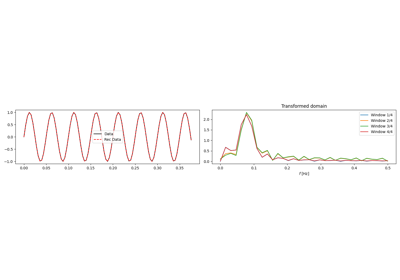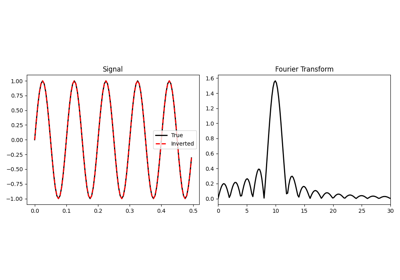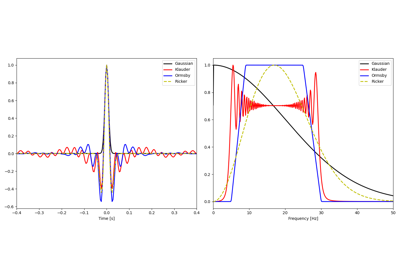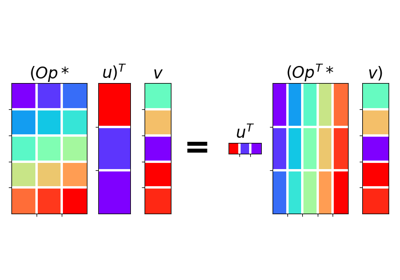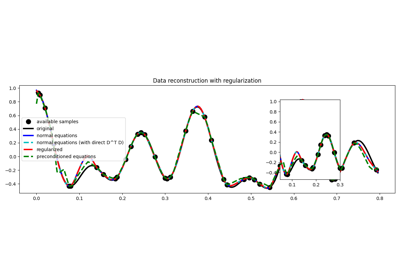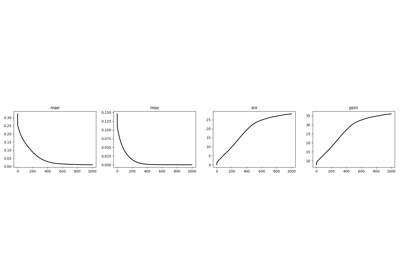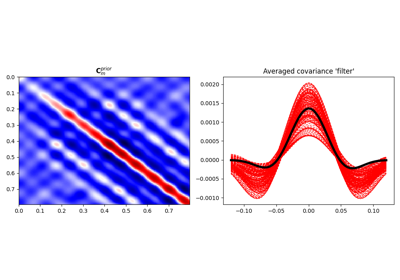pylops.signalprocessing.FFT#
- pylops.signalprocessing.FFT(dims, axis=-1, nfft=None, sampling=1.0, norm='ortho', real=False, ifftshift_before=False, fftshift_after=False, engine='numpy', dtype='complex128', name='F', **kwargs_fftw)[source]#
One dimensional Fast-Fourier Transform.
Apply Fast-Fourier Transform (FFT) along an
axisof a multi-dimensional array of sizedim.Using the default NumPy engine, the FFT operator is an overload to either the NumPy
numpy.fft.fft(ornumpy.fft.rfftfor real models) in forward mode, and tonumpy.fft.ifft(ornumpy.fft.irfftfor real models) in adjoint mode, or their CuPy equivalents. Whenengine='fftw'is chosen, thepyfftw.FFTWclass is used instead. Alternatively, when the SciPy engine is chosen, the overloads are ofscipy.fft.fft(orscipy.fft.rfftfor real models) in forward mode, and toscipy.fft.ifft(orscipy.fft.irfftfor real models) in adjoint mode.When using
real=True, the result of the forward is also multiplied by \(\sqrt{2}\) for all frequency bins except zero and Nyquist, and the input of the adjoint is multiplied by \(1 / \sqrt{2}\) for the same frequencies.For a real valued input signal, it is advised to use the flag
real=Trueas it stores the values of the Fourier transform at positive frequencies only as values at negative frequencies are simply their complex conjugates.- Parameters
- dims
tuple Number of samples for each dimension
- axis
int, optional New in version 2.0.0.
Axis along which FFT is applied
- nfft
int, optional Number of samples in Fourier Transform (same as input if
nfft=None)- sampling
float, optional Sampling step
dt.- norm{“ortho”, “none”, “1/n”}, optional
New in version 1.17.0.
“ortho”: Scales forward and adjoint FFT transforms with \(1/\sqrt{N_F}\), where \(N_F\) is the number of samples in the Fourier domain given by
nfft.“none”: Does not scale the forward or the adjoint FFT transforms.
“1/n”: Scales both the forward and adjoint FFT transforms by \(1/N_F\).
Note
For “none” and “1/n”, the operator is not unitary, that is, the adjoint is not the inverse. To invert the operator, simply use
Op \ y.- real
bool, optional Model to which fft is applied has real numbers (
True) or not (False). Used to enforce that the output of adjoint of a real model is real.- ifftshift_before
bool, optional New in version 1.17.0.
Apply ifftshift (
True) or not (False) to model vector (before FFT). Consider using this option when the model vector’s respective axis is symmetric with respect to the zero value sample. This will shift the zero value sample to coincide with the zero index sample. With such an arrangement, FFT will not introduce a sample-dependent phase-shift when compared to the continuous Fourier Transform. Defaults to not applying ifftshift.- fftshift_after
bool, optional New in version 1.17.0.
Apply fftshift (
True) or not (False) to data vector (after FFT). Consider using this option when you require frequencies to be arranged naturally, from negative to positive. When not applying fftshift after FFT, frequencies are arranged from zero to largest positive, and then from negative Nyquist to the frequency bin before zero.- engine
str, optional Engine used for fft computation (
numpy,fftw, orscipy). Choosenumpywhen working with cupy arrays.Note
Since version 1.17.0, accepts “scipy”.
- dtype
str, optional Type of elements in input array. Note that the
dtypeof the operator is the corresponding complex type even when a real type is provided. In addition, note that neither the NumPy nor the FFTW backends supports returningdtypedifferent thancomplex128. As such, when using either backend, arrays will be force-casted to types corresponding to the supplieddtype. The SciPy backend supports all precisions natively. Under all backends, when a realdtypeis supplied, a real result will be enforced on the result of thermatvecand the input of thematvec.- name
str, optional New in version 2.0.0.
Name of operator (to be used by
pylops.utils.describe.describe)- **kwargs_fftw
Arbitrary keyword arguments for
pyfftw.FTTW
- dims
- Raises
- ValueError
If
dimsis provided andaxisis bigger thanlen(dims).If
normis not one of “ortho”, “none”, or “1/n”.
- NotImplementedError
If
engineis neithernumpy,fftw, norscipy.
Notes
The FFT operator (using
norm="ortho") applies the forward Fourier transform to a signal \(d(t)\) in forward mode:\[D(f) = \mathscr{F} (d) = \frac{1}{\sqrt{N_F}} \int\limits_{-\infty}^\infty d(t) e^{-j2\pi ft} \,\mathrm{d}t\]Similarly, the inverse Fourier transform is applied to the Fourier spectrum \(D(f)\) in adjoint mode:
\[d(t) = \mathscr{F}^{-1} (D) = \frac{1}{\sqrt{N_F}} \int\limits_{-\infty}^\infty D(f) e^{j2\pi ft} \,\mathrm{d}f\]where \(N_F\) is the number of samples in the Fourier domain
nfft. Both operators are effectively discretized and solved by a fast iterative algorithm known as Fast Fourier Transform. Note that the FFT operator (usingnorm="ortho") is a special operator in that the adjoint is also the inverse of the forward mode. For other norms, this does not hold (seenormhelp). However, for any norm, the Fourier transform is Hermitian for real input signals.- Attributes
- dimsd
tuple Shape of the array after the forward, but before linearization.
For example,
y_reshaped = (Op * x.ravel()).reshape(Op.dimsd).- f
numpy.ndarray Discrete Fourier Transform sample frequencies
- real
bool When
True, usesrfft/irfft- rdtype
bool Expected input type to the forward
- cdtype
bool Output type of the forward. Complex equivalent to
rdtype.- shape
tuple Operator shape
- clinear
bool New in version 1.17.0.
Operator is complex-linear. Is false when either
real=Trueor whendtypeis not a complex type.- explicit
bool Operator contains a matrix that can be solved explicitly (
True) or not (False)
- dimsd
